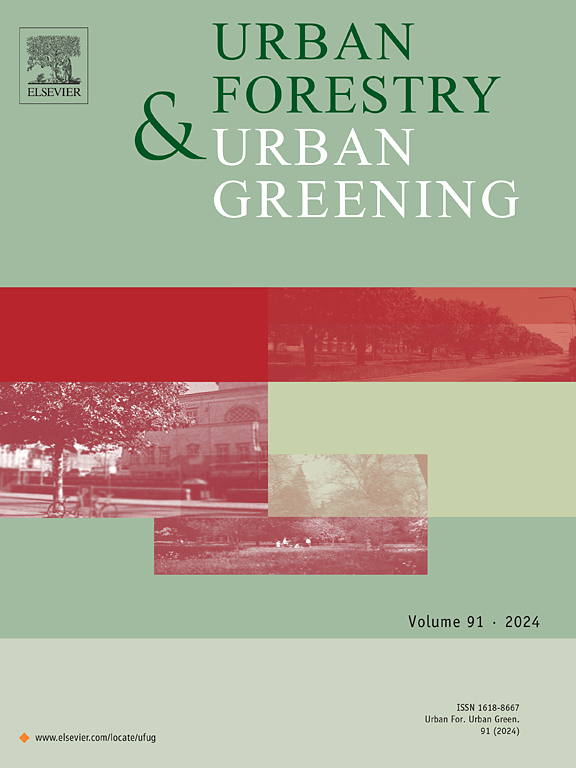Predicting the impact of integrated audio-visual environments on perceived restorative benefits across different park types: A field study based on seven parks in Hangzhou, China
IF 6
2区 环境科学与生态学
Q1 ENVIRONMENTAL STUDIES
引用次数: 0
Abstract
The human perception of environments is a complex mechanism, influenced not only by visual and auditory stimuli and their perceptual outcomes, but also by personal characteristics, site types, and other factors that affect people's restorative experiences. However, there is little research that treats it as a complete systemic phenomenon to reveal its integrated impact. We surveyed 1161 visitors in seven urban parks in Hangzhou, China, and collected information on audio-visual stimuli. Using structural equation modeling and multi-group analysis, we initially examined the comprehensive impact of acoustic factors, non-acoustic factors, and individual characteristic variables on perceived restorativeness. Subsequently, we studied the effects of different park types on the constructed multivariate comprehensive model. The results confirm that the presence of different types of sound sources within landscape features can impact the auditory affective quality dimension, which in turn affects visitors' perceived restorative experiences. In addition, the reported mediating pathways revealed that visual elements related to nature, by providing high-quality visual landscapes, enhance the pleasantness of soundscapes and yield greater restorative benefits in park environments. A new finding of the study was that, although the eventfulness of the soundscape negatively affects perceived restorativeness, the presence of high-quality visual landscapes in the environment can compensate for this deficiency. Further multi-group analysis results show that landscape features and visual perceptual quality indirectly influence perceived restorativeness through the auditory affective quality dimension, resulting in varied correlations across two types of park. Moreover, the pleasantness of soundscapes consistently has a significant effect on perceived restorativeness in both types of parks; however, in parks oriented towards activity, the eventfulness dimension of soundscapes does not significantly affect perceived restorativeness. Lastly, the influence of landscape features on perceived restorativeness, mediated by types of sound sources, is both direct and indirect, leading to diverse correlations across different park environments. These detailed findings and guidelines for audio-visual interaction design will aid in the planning and development of urban soundscapes.
预测不同类型公园的综合视听环境对可感知的恢复性益处的影响:基于中国杭州七个公园的实地研究
人类对环境的感知是一种复杂的机制,不仅受到视觉和听觉刺激及其感知结果的影响,还受到个人特征、场地类型和其他影响人们恢复体验的因素的影响。然而,很少有研究将其作为一个完整的系统现象来揭示其综合影响。我们在中国杭州的七个城市公园对 1161 名游客进行了调查,并收集了视听刺激信息。通过结构方程建模和多组分析,我们初步研究了声学因素、非声学因素和个体特征变量对感知恢复性的综合影响。随后,我们研究了不同公园类型对所构建的多元综合模型的影响。结果证实,景观特征中不同类型声源的存在会影响听觉情感质量维度,进而影响游客感知的恢复性体验。此外,所报告的中介路径显示,与自然相关的视觉元素通过提供高质量的视觉景观,可以增强声音景观的愉悦性,并在公园环境中产生更大的恢复效果。研究的一个新发现是,虽然声音景观的多变性会对感知的恢复性产生负面影响,但环境中高品质视觉景观的存在可以弥补这一不足。进一步的多组分析结果表明,景观特征和视觉感知质量会通过听觉情感质量维度间接影响人们感知到的恢复性,从而在两类公园中产生不同的相关性。此外,在两类公园中,声音景观的悦耳程度对感知恢复性都有显著影响;然而,在以活动为主的公园中,声音景观的事件性维度对感知恢复性没有显著影响。最后,在声源类型的中介下,景观特征对感知恢复性的影响既有直接影响,也有间接影响,从而导致不同公园环境中的相关性各不相同。这些详细的研究结果和视听互动设计指南将有助于城市声音景观的规划和发展。
本文章由计算机程序翻译,如有差异,请以英文原文为准。
求助全文
约1分钟内获得全文
求助全文
来源期刊

Urban Forestry & Urban Greening
FORESTRY-
CiteScore
11.70
自引率
12.50%
发文量
289
审稿时长
70 days
期刊介绍:
Urban Forestry and Urban Greening is a refereed, international journal aimed at presenting high-quality research with urban and peri-urban woody and non-woody vegetation and its use, planning, design, establishment and management as its main topics. Urban Forestry and Urban Greening concentrates on all tree-dominated (as joint together in the urban forest) as well as other green resources in and around urban areas, such as woodlands, public and private urban parks and gardens, urban nature areas, street tree and square plantations, botanical gardens and cemeteries.
The journal welcomes basic and applied research papers, as well as review papers and short communications. Contributions should focus on one or more of the following aspects:
-Form and functions of urban forests and other vegetation, including aspects of urban ecology.
-Policy-making, planning and design related to urban forests and other vegetation.
-Selection and establishment of tree resources and other vegetation for urban environments.
-Management of urban forests and other vegetation.
Original contributions of a high academic standard are invited from a wide range of disciplines and fields, including forestry, biology, horticulture, arboriculture, landscape ecology, pathology, soil science, hydrology, landscape architecture, landscape planning, urban planning and design, economics, sociology, environmental psychology, public health, and education.
 求助内容:
求助内容: 应助结果提醒方式:
应助结果提醒方式:


